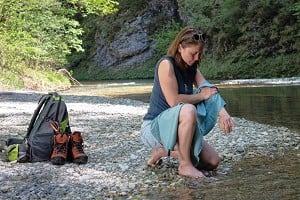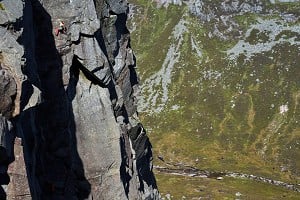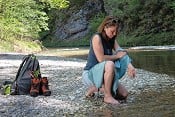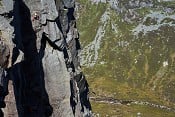
What is the safest way to hold and use a single alpine ice axe whilst ascending a 45 degree hard pack snow slope, unroped. Is it to hold the head with pick towards the snow, or away from the snow. Some daggering required. With a leash, or without a leash.
Pick always towards snow, with leash or cows tail to harness.
Ps. If you need to ask try and get some tuition. Can you brake a slide etc.
Yes, adze forards and pick facing backwards in your hand so that if you slide it's a simple matter (you hope) to get stabilised then roll sideways onto the pick to self-arrest.
It depends on the crampon technique you are using, and whether you are planting the pick or the spike.
If holding the pick (planting the spike) then always have the pick facing backwards to facilitate an ice-axe arrest.
Edit: I don't use a leash with a single axe because you are likely to be swapping hands a lot (when reversing uphill side) and the risk of tripping is too high.
> Hi,
> Have you and Summo said the opposite direction?
> Thanks!
> Jon.
Yes - the first two responses are absolutely contradictory. I think the reference to 45 degrees in the OP is the problem. 45 degrees is steep. Below around 35 degrees it's normally pick backwards with shaft in the snow (walking stick fashion). Once steep enough (and hard-packed enough) to want to dagger the snow with the pick, then it's obviously pick forwards. The change-over point for most folk would be around 35-45 degrees but it hugely depends on the nature of the snow.
As Summo has said, if you need to ask, you probably need more detailed instruction than this forum will provide. MLT handbook Volume 3 "Winter Skills" is a good starting point.
Martin
Hi Martin,
Thanks for the reply! What you're saying is consistent with what I was thinking (but not very confidently), but I'm still learning. I've got that book (and am planning to do a winter course to gain more experience in the upcoming winter if I can get my fitness back in time...)
Jon.
Whatever happens you need to practice self-arrest if you can find a safe concave slope. It needs to become instinctive to get stabilised then manouver your body into a feet-first self-arrest position. The first stage of the sequence includes keeping the axe well clear and in control so that you don't roll over it and stab yourself.
Thank you for highlighting the nub of the dilemma. I find that my changeover point to pick forward is around 40 degrees on hardpack on an alpine approach. I have observed various techniques in the alps this year of varying quality. I am genuinely interested in the wisdom of the UKC forum and any consensus.
This, and lifting your feet braking only with your knees (and of course the axe). Otherwise, if your crampons catch, you will somersault backwards and fly off.
CB
On 45 degree - or even 30 degree - hard packed snow, things will happen exceedingly quickly. You probably have less than half a second before you have built up so much speed that doing anything about it is very difficult or nigh on impossible. Its important to practice getting into the arrest position very fast and instinctively, so the advice of finding safe (that is with easy run out) slopes and practising is very good. Personally I would say leash on - the forces involved in a fast arrest are high and there is a real chance of the axe being ripped from you.
> Personally I would say leash on - the forces involved in a fast arrest are high and there is a real chance of the axe being ripped from you.
I've never understood this. I can't imagine losing my axe while trying to self-arrest but getting it back under control because I were using a leash. What I can imagine is it flailing around attached to me, with potential to cause further serious injury.
Worst comes to the worst you can get an axe in above your head, as I found out to my relief once. Traversing a steep slope, the axe in the up hill hand is already a bit high to get under the body, so when I slipped / tripped, the best course of action for me was just bang the pick in above me before I had chance to pick up speed. I doubt I'd have held it without the leash.
Fair point. I hate having a leash on my mountaineering axe - it makes swapping hands an absolute faff, which I think could easily lead to using the axe suboptimally and make needing to self-arrest to begin with more likely.
But each to their own! It'd be a dull world if we all thought the same
>Once steep enough (and hard-packed enough) to want to dagger the snow with the pick, then it's obviously pick forwards.
I would still be holding the head of the axe in my uphill hand, pick facing backwards/towards the snow. With the shaft in my downhill hand I could thus place the pick into the snow on my uphill side, little finger of uphill hand against the snow.
I avoid front pointing (with both feet) when using a single axe because there is a risk of going over backwards as you remove the pick. Thus I am always facing at least somewhat sideways and so have an uphill side to hold the axe on.
At 45 degrees I'd probably be daggering going straight up the slope on my toes. 50 or 55 and up- two axes and both daggering.
Pick pointing to the rear is only for walking, zig zagging up lower angles etc. No leash to speed up hand changes.
50 degrees upwards is getting into grade 1 or 2. So most folk won't be zig zagging.
If you are daggering, leaning your weight onto the axe there should be zero risk of falling backwards.
> Thank you for highlighting the nub of the dilemma. I find that my changeover point to pick forward is around 40 degrees on hardpack on an alpine approach. I have observed various techniques in the alps this year of varying quality. I am genuinely interested in the wisdom of the UKC forum and any consensus.
I think you are over analysing. There is no precise angle etc. You just judge by how it feels, how solid the snow pack is and personal fitness, as it is obviously much quicker to go straight up daggering than zig zagging. The same when descending, you can scuttle straight down very quickly daggering after a bit of practice, much faster and often safer than facing out zig zagging. If you just larks foot your sling on the axe it takes seconds to remove, so there isn't any chance of catching it on a crampon.
> 50 degrees upwards is getting into grade 1 or 2. So most folk won't be zig zagging.
> If you are daggering, leaning your weight onto the axe there should be zero risk of falling backwards.
Except that OP only has the one axe so he or she cannot lean into the axe while simultaneously repositioning it. Front pointing with one axe is certainly possible but I could not recommend it as the safest way to use an ice axe. If you get onto terrain where you cannot use hybrid technique (pied troisieme) and only have a single axe then the safest thing would quite possibly be to retreat.
> Except that OP only has the one axe so he or she cannot lean into the axe while simultaneously repositioning it. Front pointing with one axe is certainly possible but I could not recommend it as the safest way to use an ice axe. If you get onto terrain where you cannot use hybrid technique (pied troisieme) and only have a single axe then the safest thing would quite possibly be to retreat.
We can agree to differ. On those angles you aren't swinging axes in making placements. You can simply dagger it in with a hand over the head, the unaxed hand can just be flat palming on the snow. Of course it is down to snow conditions, how comfortable you are on your feet and so on. I'm think of some the kind of 50-55 degree terrain on sections of say north face tour ronde, ne face of lenspitze, Barre noir on Barre des ecrins etc.. It's just not efficient or practical to either double axe swing placements or zig zag. You need a technique that sits between the two and enables a spike in the snow for security and weight on feet etc. I think we all find our own path when it comes to moving quickly, efficiently and safely on mid angled terrain. No two people will switch techniques at precisely the same point.
I can't disagree with any of that, except that I would aim to avoid moving like this for any distance; most likely by having my second axe reasonably available.
Using two axes does not necessarily mean swinging placements, it can be very efficient to dagger and front point in a nice, stable way while always maintaining three points of contact.
> I can't disagree with any of that, except that I would aim to avoid moving like this for any distance; most likely by having my second axe reasonably available.
Agree. Normally in a slot on my harness (never left on the rucksack out of reach). Barely need to pause and then on the move again.
> Using two axes does not necessarily mean swinging placements, it can be very efficient to dagger and front point in a nice, stable way while always maintaining three points of contact.
Again agreed. A steady march up the slope left right left etc.
As you can probably see from the range of responses, this is one of those somewhat contentious issues with no clear answer. The is definitely no "right" was to hold your ice axe.
Funny trivia: You've probably heard about the different ice axe grips, often described by their French names, such as piolet canne, piolet traction, piolet ancre, and so on. Apparently, French climbers sometimes refer to the technique of holding the axe with the pick facing backward as "Piolet Merde" which means "Piolet Shit" because they think it's a poor way to hold an ice axe. In America, holding an ice axe this way is called the "self-arrest" grip, because it makes it easier to get into a self-arrest position, and it's quite popular.
For what it's worth, my approach is to hold my axe in self-arrest position (pick backward) on gentle/moderate slopes, and hold my axe with a different position (pick forward) anytime I have to start using the pick regularly. Sometimes I wrap my hand around the adze with the pick facing forward, and sometimes I hold shaft of the axe high under the head with the pick facing forward--that's a whole other discussion. Where that crossover happens (pick backward/pick forward) depends on the terrain and my comfort level. In general, more skilled climbers can ascend steeper slopes comfortably and safely without using the pick as an extra point of balance, while less skilled climbers will start placing the pick in the snow regularly in less steep terrain.
Regarding leashes, I never use a leash in a single axe. If you slip and fall, and you don't have your ice axe in your hand and in control, it's near-impossible to get your axe back into your hands and under your body where you can use it for self-arrest, leash or no leash. On the contrary, with a leash, the axe is simply a dangerous sharp object tethered to our body. Also, having a leash just introduces an annoying and potentially dangerous hazard when changing directions, managing a rope, getting stuff done, and so on. I think this leash question is far more settled (allowing for some outlying positions and situations). From what I've seen in the US, Switzerland, and France, very few experienced climbers and guides use a leash for a single ice axe snow travel and climbing, although I suspect howls of protest might follow that statement.
Do what makes you feel safe, solid, and smooth.
Oh, forgot to add, yes, of course, get professional instruction--it's really worthwhile. But it sounds like you're out there climbing and experimenting, and that's invaluable as well.
> I avoid front pointing (with both feet) when using a single axe because there is a risk of going over backwards as you remove the pick. Thus I am always facing at least somewhat sideways and so have an uphill side to hold the axe on.
I must say I can't see this at all. Let's follow the logic of what you are saying. On a 45 degree slope, say. With one axe, you might pull the axe out and fall over backwards? But, with two axes, you pull one axe out and start to fall over backwards, but the second axe placement stops you?
In fact, I would say that if someone's balance is so poor that they might fall over backwards, then there is a lot more chance of falling over sideways. And, if you fall over sideways (away from the slope), then I think getting any axe placement is going to be problematic.
To look at it another way. If I was on a steep slope with two axes and lost one, then I would stay front on, front-pointing with one axe. There's no way I would turn side on and try to walk up the slope just because I've only got one axe!
I can't say I've ever felt at risk of toppling off the hill backwards while front pointing with a single axe on moderate to moderately steep snow. Surely you just get in balance over your feet and palm off with the other hand like you're climbing a slab, and that keeps you in balance while you remove and re-place the axe?
For what it's worth, I hold the axe with the pick facing backwards on easy ground only. As soon as I think there's even a chance I might want to dagger, the axe gets turned around and stays that way until I'm back on easy ground. I'm also more likely to change over earlier with a technical tool than a mountaineering axe, simply because my tools don't feel as secure to me in piolet canne mode.
But take that with a pinch of salt - compared to some others posting here I'm far less experienced in the world of snow.
Edit: essentially I see self-arrest as an absolute last resort that I never plan to use, and so I go with the technique that offers maximum security for self-belay. Which will often be pick-forwards as the terrain becomes steeper.
> I can't say I've ever felt at risk of toppling off the hill backwards while front pointing with a single axe on moderate to moderately steep snow. Surely you just get in balance over your feet and palm off with the other hand like you're climbing a slab, and that keeps you in balance while you remove and re-place the axe?
Absolutely.
... and, even on a snow slope there can be quite a lot to hold onto with your spare hand: any edge on the ice, someone else's previous ice axe placements can make useful handholds, even just grabbing the snow can give you a decent hold.
Also, if you need to kick steps, then it's got to be easier front on.
> I must say I can't see this at all. Let's follow the logic of what you are saying. On a 45 degree slope, say. With one axe, you might pull the axe out and fall over backwards? But, with two axes, you pull one axe out and start to fall over backwards, but the second axe placement stops you?
Yes. Or more specifically you can pull yourself towards the slop before you start toppling, in a way that is simply impossible with just your hand. Consider that you pull on the moving axe to get it out of the snow, and to counteract that you will have been pushing with your stationary hand. When the axe pops you are basically pushing yourself off the mountain.
> In fact, I would say that if someone's balance is so poor that they might fall over backwards, then there is a lot more chance of falling over sideways. And, if you fall over sideways (away from the slope), then I think getting any axe placement is going to be problematic.
But with at least one foot sideways you have a more stable base (multiple points), and also can sometimes lean your hip or elbow against the slope. Thus you don't find yourself momentarily balanced on four points.
> To look at it another way. If I was on a steep slope with two axes and lost one, then I would stay front on, front-pointing with one axe. There's no way I would turn side on and try to walk up the slope just because I've only got one axe!
Sure but that doesn't mean that front-pointing and daggering is best practice with a single axe.
I'm not saying it isn't a valid technique, but trying to express why I avoid it.
> I'm not saying it isn't a valid technique, but trying to express why I avoid it.
The question, however, is whether it's genuinely a good idea to discourage less experienced climbers from front pointing with a single axe.
I found a Glenmore Lodge video on basic crampon technique and this confirms what others have said: that front-pointing (up and down) is the most secure way of negotiating a steeper slope, even with a single axe. It's here:
youtube.com/watch?v=NQ_WsqrP6us&
See from 7:15.
Having watched the video, I would suggest that it's dangerous to discourage this and insist on staying side on. Your aversion to front-pointing with a single axe, I suggest, is unusual and idiosynchratic. It's not what would be taught at Glenmore Lodge, for example.
> Your aversion to front-pointing with a single axe, I suggest, is unusual and idiosynchratic. It's not what would be taught at Glenmore Lodge, for example.
Fair enough, I'll pipe down. I will however continue to use french technique where possible, and risk the ire of Glenmore instructors.
IMO the key advantage of French technique is that your calves can relax because the heel is contacting the ground. When front pointing steep slopes or even ice climbing I will try and place one foot in French position whenever a little bulge or depression offers a slightly flatter foot placement. I am not worried about falling over backwards when front pointing. Feeling wobbly and needing the axe to prevent falling backwards probably indicates a problem with overall balance, in particular heel positioning and the degree of flex in the knees.
CB
> Whatever happens you need to practice self-arrest if you can find a safe concave slope. It needs to become instinctive to get stabilised then manouver your body into a feet-first self-arrest position. The first stage of the sequence includes keeping the axe well clear and in control so that you don't roll over it and stab yourself.
Possibly controversially, I am going to say this is misguided. Self-arrest is only reliably effective in my view on slopes not steep enough for it to be needed. If you are on a slope where generally flailing around is insufficient to stop you, the acceleration will mean convoluted self-arrest approaches won't work either.
> I think you are over analysing. There is no precise angle etc. You just judge by how it feels, how solid the snow pack is and personal fitness, as it is obviously much quicker to go straight up daggering than zig zagging. The same when descending, you can scuttle straight down very quickly daggering after a bit of practice, much faster and often safer than facing out zig zagging. If you just larks foot your sling on the axe it takes seconds to remove, so there isn't any chance of catching it on a crampon.
Fair comment. It's more an intuitive thing, depending on snow condition and steepness of slope, based on experience, rather than a mathematical calculation.
> As you can probably see from the range of responses, this is one of those somewhat contentious issues with no clear answer. The is definitely no "right" was to hold your ice axe.
> Funny trivia: You've probably heard about the different ice axe grips, often described by their French names, such as piolet canne, piolet traction, piolet ancre, and so on. Apparently, French climbers sometimes refer to the technique of holding the axe with the pick facing backward as "Piolet Merde" which means "Piolet Shit" because they think it's a poor way to hold an ice axe. In America, holding an ice axe this way is called the "self-arrest" grip, because it makes it easier to get into a self-arrest position, and it's quite popular.
> For what it's worth, my approach is to hold my axe in self-arrest position (pick backward) on gentle/moderate slopes, and hold my axe with a different position (pick forward) anytime I have to start using the pick regularly. Sometimes I wrap my hand around the adze with the pick facing forward, and sometimes I hold shaft of the axe high under the head with the pick facing forward--that's a whole other discussion. Where that crossover happens (pick backward/pick forward) depends on the terrain and my comfort level. In general, more skilled climbers can ascend steeper slopes comfortably and safely without using the pick as an extra point of balance, while less skilled climbers will start placing the pick in the snow regularly in less steep terrain.
> Regarding leashes, I never use a leash in a single axe. If you slip and fall, and you don't have your ice axe in your hand and in control, it's near-impossible to get your axe back into your hands and under your body where you can use it for self-arrest, leash or no leash. On the contrary, with a leash, the axe is simply a dangerous sharp object tethered to our body. Also, having a leash just introduces an annoying and potentially dangerous hazard when changing directions, managing a rope, getting stuff done, and so on. I think this leash question is far more settled (allowing for some outlying positions and situations). From what I've seen in the US, Switzerland, and France, very few experienced climbers and guides use a leash for a single ice axe snow travel and climbing, although I suspect howls of protest might follow that statement.
> Do what makes you feel safe, solid, and smooth.
What makes me feel safe, solid, and smooth is what you have advised above, namely wrapping my hand around the adze with pick forward on steeper slopes. Prevention is better than cure, less likely to need an ice axe brake in the first place which needs split second reactions. I'm always open to learn of better safer ways though.
How though, do you prevent the ice axe shaft from being ripped out of your hand in event of a fall. Whenever I do a long controlled glissade I hold bottom of the shaft with left hand supported by a sling, and right hand on top of the axe. Works fine for me every time over the years.
> IMO the key advantage of French technique is that your calves can relax because the heel is contacting the ground. When front pointing steep slopes or even ice climbing I will try and place one foot in French position whenever a little bulge or depression offers a slightly flatter foot placement. I am not worried about falling over backwards when front pointing. Feeling wobbly and needing the axe to prevent falling backwards probably indicates a problem with overall balance, in particular heel positioning and the degree of flex in the knees.
Don't forget hybrid / American technique - one foot leading by front-pointing, and the other foot flat-footing, and then when your front-pointing foot is tired, swap leading feet.
> I've never understood this. I can't imagine losing my axe while trying to self-arrest but getting it back under control because I were using a leash. What I can imagine is it flailing around attached to me, with potential to cause further serious injury.
As I understand how things are going - is that there's more emphasis on stopping falls before they happen these days, than arresting falls. To that end, I have a nice cord leash for my axe that clips to my harness. On steeper slopes I can then plunge the axe all the way in, and have a bodyweight anchor (I bet a decent proportion of slips on slopes occur when people stop to fiddle with something and lose their balance or drop something and instinctively try to grab it).
This same cord leash unclips from my harness and becomes a wrist leash for harder ice/mixed sections., or if it's easy terrain, the cord gets rolled around the shaft and clips to itself and then it's a no-leash ice axe.
I don't know about the leash being a trip hazard - doesn't seem likely at all. It's quite common in the Pacific Northwest here to have an ice axe leash and I've not heard of any tripping problems.
> Possibly controversially, I am going to say this is misguided. Self-arrest is only reliably effective in my view on slopes not steep enough for it to be needed. If you are on a slope where generally flailing around is insufficient to stop you, the acceleration will mean convoluted self-arrest approaches won't work either.
I disagree with this. When walking with pick backwards, self-arrest doesn't feel convoluted to me, it feels very intuitive. And it certainly works on slope angles on which trying to dig in crampons would end very unpleasantly once you have any speed. When I think self arrest is unlikely to be effective is when I switch to pick forward.
It'll be convoluted if you've stabbed yourself in the gaiter and launched yourself head first down the slope on your back while half asleep. Even if you have the fastest reactions in the world you're going to be sliding off downhill at some speed before you're in a position to do anything about it.
It's also probably far more likely to happen like that than the neat scenarios we all practice and make ourselves prepared for.
If you stumble, you should hit the deck in self arrest position, or be able reach this position with one rotation around one body axis if your stumble starts in an unfortunate direction. Falling down and then sorting yourself out while sliding is indeed too slow, so stumbling correctly needs to become second nature.
CB
Thankyou for your interesting response.
I have watched this video demonstrating ice axe/crampon technique on easy angle slopes of approx 25 degree at a guess. There is a demo of how to descend at 8:40. Quote..."if it becomes too steep to stay upright, just daggering your axe using the pick of your axe"... So, why not demo it on a steep slope, along with ascending it on a steep slope. The demo looked awkward and unnatural, the instructor having to bend right over to place the axe. It is the middlin steep slopes that interest me, with alpine 60cm axe, 45 degrees, on hard pack snow, and unroped. Actual safety and perceived safety are two different things. I have witnessed newcomers using the easy angle technique on a steep slope because that is how they were taught and that is all they know. As several experienced contributors have stated, over time an understanding of the various combinations of snow conditions and angles of slope will be instinctive, and how and when to switch to a safer way to use an axe. At present this appears to be a grey area, I would like to see more clarity.
All the talk seem to be pick back or forward, I find I often plunge with the axe directly in front of me (or almost so) in-between, as the slope steepens, depending on snow condition. In this position the top of the axe is used as a handle, positioned across the slope, either with one hand over the top of the axe, or both hands (ie one on adze other on pick). Angle of plunge depends of steepness of slope, and immediate security is usually possible with extra deep plunges as necessary, although doesn't work well on very firm snow.
OK that's fine in soft snow conditions suitable for plunging. So what safe techniques do you use when you are on middlin steep slopes of around 45 degrees, on hard pack snow, unroped, using alpine 60 cm axe. In theses conditions the spike will only just penetrate the surface up to an inch or so. Do you use pick in, pick out, pick and spike in, hold the head of the axe, hold the shaft of the axe, with a leash to harness, with wrist loop to axe, or leashless. All this in combination of appropriate safe crampon techniques. Common examples would be on an alpine PD route.
Poles.
Thanks Jon, I'm quite a fan of poles and will admit to using a pole and an axe at times. But usually I will have packed the pole away as the angle steepens, in order that I can fully control a safe ice axe brake if required.. This one is definitely a personal preference thing, depending on an individuals comfort zone angle. Different strokes for different folks.
There speaketh the guide Having only had to ice axe break once in my life, I reckon you're right.
I acknowledge your joint wisdoms.
> I'm quite a fan of poles and will admit to using a pole and an axe at times. But usually I will have packed the pole away as the angle steepens, in order that I can fully control a safe ice axe brake if required..
Prevention is better than cure
Retired and still alive
Absolutely. I'm great fan of that. I shall endeavour to use poles more, and axe less. I'll let you know how I get on. I hope.
My feeling is that you should do whatever you feel most comfortable with, not what folk tell you to do, or what you might see others doing. Once outside your comfort zone err on the side of caution. I really like one pole and one axe. If you don't put your hand through the loop on the pole then you can always drop it and (try to) ice axe arrest. But of course you won't need to.........
I'll chime in again.
I'm not trying to be confrontational, but it does seem as if you have received numerous diverse and useful responses, but you're still searching for something more, some kind of specific answer, when the gist is, "There is no right answer, do what feels good for you." You also seem to be responding to each post with a manner that's not quite defensive, but almost dismissive, as if to say, "Yes, I know that, but what about this (further situation)? So I guess I don't really know what you are looking for; do you want an answer for a specific situation? As above, I think the answer is that there is no right answer. Do you want a survey of different responses? You have received lots of good responses already....
OK, with that out the way, what about the situation you describe?
"So what safe techniques do you use when you are on middlin steep slopes of around 45 degrees, on hard pack snow, unroped, using alpine 60 cm axe. In theses conditions the spike will only just penetrate the surface up to an inch or so. Do you use pick in, pick out, pick and spike in, hold the head of the axe, hold the shaft of the axe, with a leash to harness, with wrist loop to axe, or leashless. All this in combination of appropriate safe crampon techniques. Common examples would be on an alpine PD route."
If I was on a 45 degree slope that was so hard that the spike would only penetrate a inch, I would consider that ice climbing. If I could not plunge the shaft deep into the surface, or if I really needed to swing the axe from the bottom of the shaft to get the pick to stick, that's low angle ice climbing. If the surface is really so hard that the spike will not penetrate more than an inch, then holding the axe high on the shaft near the head or on the head with the pick facing forward isn't going to do anything; If you tried to place the pick from either of these positions it would just slide sway. And of course self-arrest on a slope like that would be incredibly difficult. So the only way you could use the axe is as a simple balance point (and nothing more) perhaps in combination with a trekking pole.
On that kind of terrain I would look down, and think about the run out, dangers like crevasses, cliffs, rocks, and so on, and I would look up, and see if the terrain got steeper above or leveled off, and how long the 45 degree section lasted, and what the conditions looked like just ahead (for example much softer snow visible a sort distance ahead). I would also think about how secure I felt on my feet, with whatever techniques and tools I was using. Basically, I would think about the consequences and likelihood of a fall.
Then I would put that together and decide whether to continue or change tactics. If I felt solid and it was just a short distance to safer terrain, I would probably continue, using the spike as a balance point, holding the axe with the pick forward or back, whichever felt more comfortable and supportive (and therefor safe). I wouldn't worry about self-arrest because it would be impossible. I would not use a leash, because, for the reasons mentioned above, I think leashes of any kind in most situations are useless, provide a false sense of security, and complicate movement, and are therefore potentially dangerous. To answer your previous question about leashes (paraphrased) "How do you keep your axe from sliding out of your hand?" by holding onto the axe with a strong grip and using good gloves.
All that said, if the 45 degree ice slope continued for any length, I would probably out on a harness and rope and start climbing together with a partner and a running belay. Putting on a harness on a 45 degree ice slope, and dealing with ropes and gear would hard and dangerous, so I would be sure to anchor myself first with an ice screw and kick/chop a small platform. Then I would climb, again, using whatever technique felt most comfortable and safe, either standing up and walking using the spike for balance, or facing in and holding the bottom of the shaft and swinging my ice axe to get real pick placements. If I encountered this terrain on a descent, I would probably face in and down climb, maybe with a running belay or a real belay.
I think it's important to consider that a 45 degree ice slope, while perhaps easy enough to walk on, is not a place you want to fall. One trip and you can break your ankle, to say nothing of falling with no chance of stopping.
If I have miss-interpreted you scenario, and you were not imagining the slope to be quite so hard (ice) well, then, see all the responses above. If you can plunge the shaft or place the pick from any hand position near the head, just do what feels safe and solid and smooth, for you.
Excellent reply.. Many thanks for taking the time to provide comprehensive information details. Just what I was looking for. This should serve as a good source of information for all UKC users to make reference to, and benefit from. I've given you thumbs up for that. By the way, thanks to all the other respondents who have given their time to reply.
All the best.
I seem to recall reading somewhere that the French don't regard ice axe braking as a thing, it's just not something they do. Certainly it wasn't covered on the UCPA courses that my kids attended this summer.
Thanks Inchewan. As I said, I wasn't trying to be confrotational, I was just trying to figure out what you were looking for. I hope it didn't come off as preachy/superior. God knows, I no expert, and I've made all the mistakes in the book, including not following most of my own advice above, which lead to the one and only time I actually needed to self-arrest Have fun climbing, and stay safe.
> I seem to recall reading somewhere that the French don't regard ice axe braking as a thing, it's just not something they do. Certainly it wasn't covered on the UCPA courses that my kids attended this summer.
I've seen it taught little bit but nowhere near as much as in the UK. I've also seen it demonstrated (with a spectacular lack of success and much loss of skin... ) on hard gritty glacier ice on the Mer de Glace!!!
> I seem to recall reading somewhere that the French don't regard ice axe braking as a thing, it's just not something they do. Certainly it wasn't covered on the UCPA courses that my kids attended this summer.
Probably because if you have cover 10km of snowy Scottish hills to reach your winter climb, you break trail and flog yourself etc.
In France they ski.
Ps. Yes I know you might still traverse steep snow on foot
Because effective ice-axe braking on steep slopes is fantastically hard to do successfully.
> Because effective ice-axe braking on steep slopes is fantastically hard to do successfully.
I did my first serious ice-axe brake this year. I was front pointing sideways across a slope and I thought the snow was improving, so I turned sideways. But, it was just a brittle layer on black ice that came away immediately and I was gone.
I stopped after about 6m. I had some coils in my left hand and although I didn't feel any great pull it might have been the rope going tight that finally stopped me. I felt like I was gradually slowing down in any case. It was hard ice, but luckily not too steep.
The two lessons are:
If in doubt front-pointing is much more secure on poor snow or icy conditions.
Be scrupulous about shortening the rope on steep, exposed slopes. The sooner your partner cuts in as an additional brake the better.
Just curious, have you been short-fixing or how did you manage the rope? I always thought that without a really good short rope technique (though I am no guide!), the odds of catching a fall when tied in on a ice slope without any pro are pretty low...
We were just moving together across an easy slope. About 5-6m apart. I had a few coils in my hand.
Elsewhere on the site
Alpine Conditions
This Alpine Conditions page gives a summary of what is being climbed at the moment, what is 'in' nick and what the prospects are...








